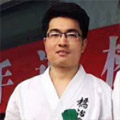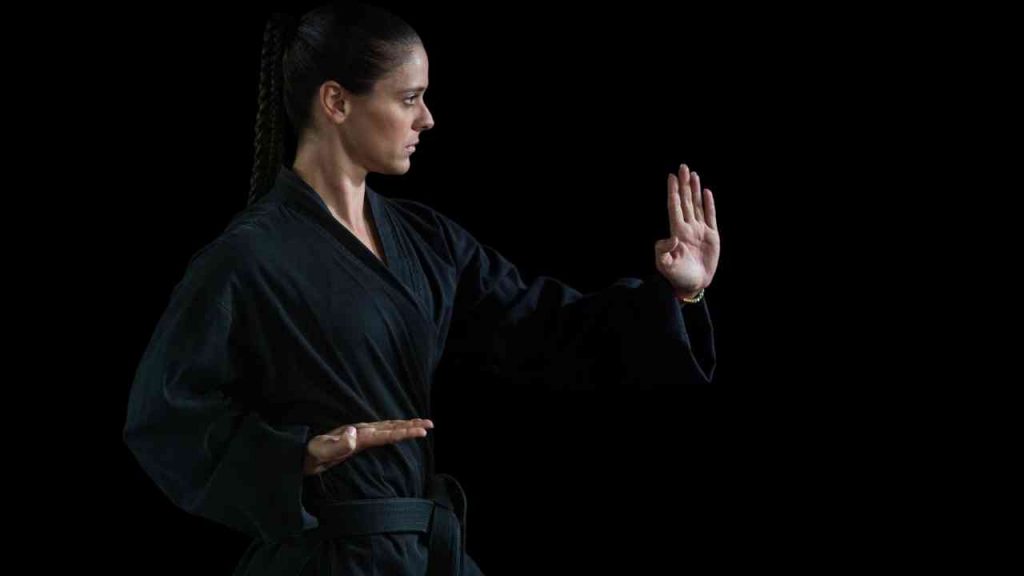Probably amongst the most unique of the different forms of Karate, Goju-Ryu is the only one that has remained closest to its original roots. While other forms of Karate have bifurcated with the passage of time, Goju Ryu karate has been able to preserve its essence.
Wondering what Goju Ryu karate is all about?
Well, in this blog, I will be taking you through the different nuances of Goju-Ryu karate by tracing its history, katas, belt system and other features. So, without further ado, let’s dive right in!
Table of Contents
What is Goju-ryu Karate?
Goju-ryu Karate, a mixture of hard and soft techniques, is one of the main traditional Okinawan karate. The hard-soft technique of the art form comprises closed hand techniques which are hard and open hand techniques and circular movements which are soft. Combining hard-soft technique with logic and timing, Goju-ryu karate requires little natural strength. Through this style, a small person can neutralize a much bigger and stronger opponent easily.
In the word ‘Goju-ryu’, ‘go’ is the notion of the concentrated force or hardness whereas ‘ju’ is the notion of pliability or softness. The term ‘ryu’ which means stream refers to the traditional lineage of the martial art form, passed from teachers to students for generations. That being said, let’s take a look at how this style of Karate came to be!
Brief History of Goju-ryu Karate
In 1873, Kanryo Higashionna, a martial arts master, traveled to Fuzhou and began studying under several teachers from China. One of the teachers was Ryu Ryu Ko, master of the art of Whooping Crane Kung Fu. Eventually, in 1882, Higashionna returned to Okinawa and began teaching a new style which was a combination of his knowledge of Okinawan styles and the martial art styles he learned in China.
Chojun Miyagi was one of his best students who began training under him from the age of 14. When Higashionna died, Miyagi continued to train his other students. Like his master, Miyagi also traveled to China to study martial arts and came back to Japan with much more refined knowledge. Then in 1930, a martial art demonstrator asked Jin’an Shinzato, a student of Miyagi, what kind of martial arts he practiced. He and Miyagi then decided to call it Goju-ryu Karate.
Goju-ryu Karate Belt Order
Like other forms of karate, the Goju-ryu also follows a dedicated belt ranking system. Let me assure you that reaching all these levels takes the utmost dedication and determination. Having said that, the belt order followed for Goju-ryu Karate is mentioned in the table below.
| Belt Color | Rank |
|---|---|
| White | Ungraded |
| White with tab | 10th kyu |
| Blue | 9th kyu |
| Blue with tab | 8th kyu |
| Yellow | 7th kyu |
| Yellow with tab | 6th kyu |
| Green | 5th kyu |
| Green with tab | 4th kyu |
| Brown | 3rd kyu |
| Brown with tab | 2nd kyu |
| Brown with 2 tabs | 1st kyu |
Goju-ryu Karate Katas
‘Kata’ is a Japanese word meaning ‘form’. Kata is a series of standardized movements or forms which are followed in all forms of karate to practice offensive and defensive techniques. Goju-ryu Karate has 12 main katas listed below.
| Kata | Meaning |
|---|---|
| Gekisai Dai Ichi | ‘attack and destroy’ is a very basic technique to allow the artist to have a stronger stance |
| Gekisai Dai Ni | ‘attach and destroy’ same as Gekisai Dai Ichi with more focus on open hand techniques |
| Saifa | ‘to destroy and defeat’ includes circular striking techniques using whip-like motions to escape the attack |
| Seiyunchin | ‘to control and pull into battle’ a technique to build the strength of hips and legs |
| Sepai | ’18 hands’ includes a wide variety of hand, foot, and body movements |
| Shisochin | ‘fight in four directions’ with major emphasis on open hand techniques coordinated with hip movements |
| Sanseiru | ’36 hands’ includes low kicks and hand techniques |
| Kururunfa | ‘holding on long and striking suddenly’ includes open hand techniques with hip coordination |
| Seisan | ’13 hands’ includes various soft hand techniques |
| Suparinpei | ‘108 hands’ is the longest kata combining techniques with controlled berating |
| Sanchin | ‘3 conflicts’ with focus on coordination of the mind and body through controlled breathing |
| Tensho | ‘rotating palms or revolving hands’ includes circular soft hand techniques |
Goju-ryu Karate Hand and Arm Techniques
Some punches and hand strikes used in Goju-ryu Karate are as follows:
| Move | Meaning |
|---|---|
| Tzuki | Punch |
| Uchi | Strike |
| Seiken Zuki or Choku Zuki | Basic punch with a closed fist |
| Oi Zuki | Lunging punch |
| Gyaku Zuki | Reverse punch involving twisting of hips |
| Age zuki | Rising punch |
| Ura zuki | Short punch with palm side up |
| Furi zuki | Circular punch delivered in the coordination of swinging hip, top of the hand face inwards |
| Hiji uchi or hiji ate | Elbow strike |
| Shuto uchi | Knife hand strike to the neck |
| Tettsui uchi | Bottom strike with a closed fist |
| Shotei zuki | Palm heel thrust with wrist bent bank, strike made with the bottom of the hand |
| Keiko-ken zuki | One knuckle fist punch, index finger held in place by the thumb |
| Nakadaka ippon-ken zuki | Middle knuckle punch, middle finger held in place by thumb and index finger |
| Ko uchi | Bent wrist strike |
| Kote uchi | Forearm strike |
Goju-ryu Karate Kicks
Some well-known and often used kicks in Goju-ryu Karate have been mentioned below:
| Move | Meaning |
|---|---|
| Keri (geri) | Kick |
| Mae geri | Front kick |
| Ushiro geri | Back thrust kick |
| Yoko geri | Sidekick |
| Kansetsu geri | Stamping joint kick |
| Mae tobi geri | Jumping front kick |
| Tobi geri | Jumping kick |
| Tobi nidan geri | Jumping double kick |
| Ushiro tobi geri | Jumping back kick |
| Yoko tobi geri | Jumping back kick |
| Ura yoko giri | Spinning side kick |
| Ura yoko tobi geri | Spinning jumping side kick |
| Kakatoto oshi | Heel kick |
| Mikazuki geri | Crescent kick |
| Ura mikazuki tobi geri | Spinning jumping crescent kick |
Goju-ryu Karate Stances
Goju-ryu Karate follows ten basic stances. Let’s a take a look at each stance and what it means below:
| Stance | Meaning |
|---|---|
| Heisoku dachi | Feet together stance |
| Musubi dachi | Heels together toes apart stance |
| Uchi Hachiji Dachi | Feet shoulder width toes pointed in |
| Heiko Dachi | Feet parallel and shoulder-width |
| Hachiji Dachi | Feet shoulder width toes pointed out |
| Shiko dachi | Sumo stance |
| Zenkutsu Dachi | Fighting stance |
| Renoji Dachi | Letter L stance |
| Neko Ashi Dachi | Cat stance |
| Sanchin Dachi | Sanchin stance |
Is Goju-ryu Karate effective for self-defense in a real fight?
If taught properly, all Karate styles are an effective form of self-defense. Similarly, Goju-ryu Karate style was designed as a form of personal protection and self-defense, not for sport fighting. Some of the defining features of Goju-ryu Karate are precise flowing movements, sharp and hand punches and kicks, a strong focus on breathing techniques, and harmony between mind and body.
If practiced regularly, these features will allow an individual to take down even a bigger and stronger opponent. The idea is not to invest a lot of physical strength but rather indulge in movements with precision and dexterity. These karate styles are, hence, useful across all ages, gender, and physical capabilities.
Additionally, knowing that you possess the ability to protect yourself and friends and family in dangerous situations gives you immense confidence. This courage will strengthen your personality and make you a better person.
Recommended Goju-ryu Karate Books
You can refer to these books below in order to build a detailed knowledge about Goju-Ryu karate:
- Goju Ryu Karate Kyohan by Yamaguchi, Gogen (2013)
- The Kata and Bunkai of Goju-Ryu Karate: The Essence of the Heishu and Kaishu Kata
- Fundamentals of Goju-Ryu Karate
- Suparinpei: The Last Kata of Goju-Ryu Karate
- The Essence of Goju Ryu – Vol I
- 17 Goju Ryu Karate Kata
Summing It Up
In order to master any art, it is imperative to have a comprehensive knowledge of the same. Goju-ryu karate needs dedication, willpower, and constant commitment. Therefore, you must try to build up as much knowledge as you can. For more such articles on everything Karate, feel free to check out my other articles.


